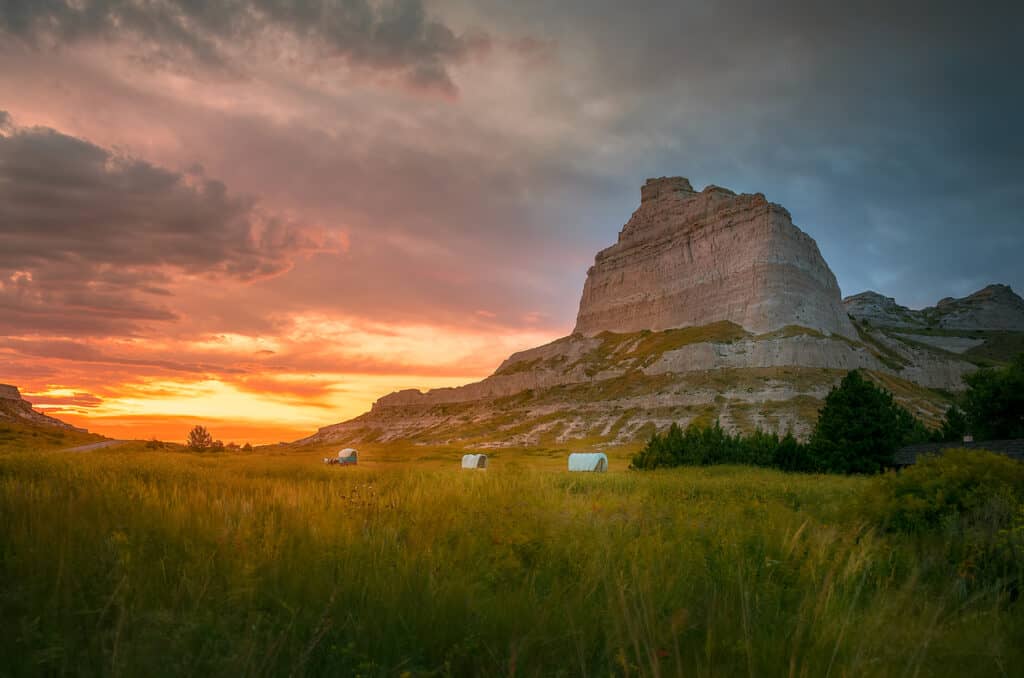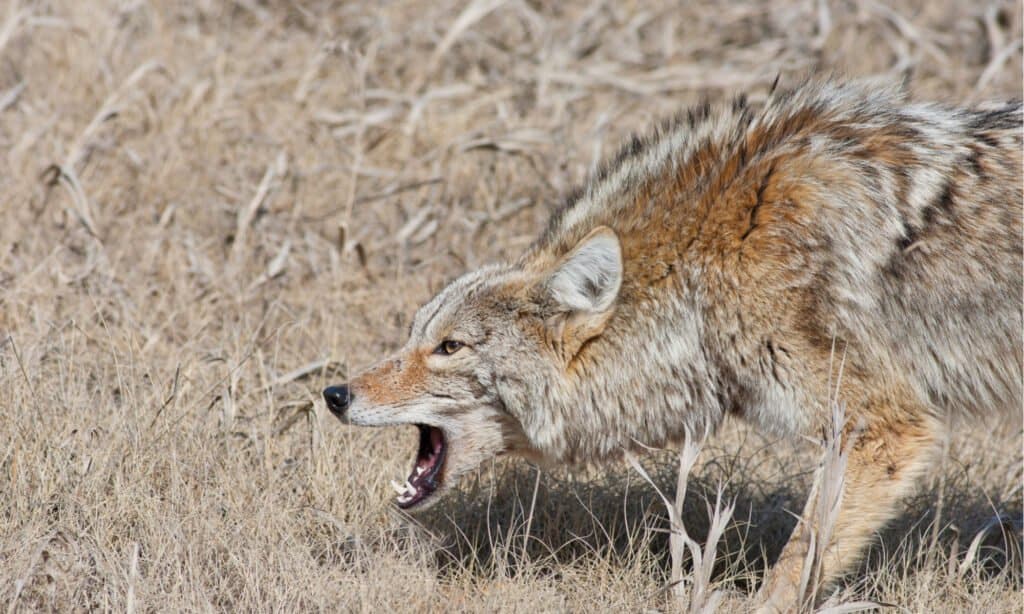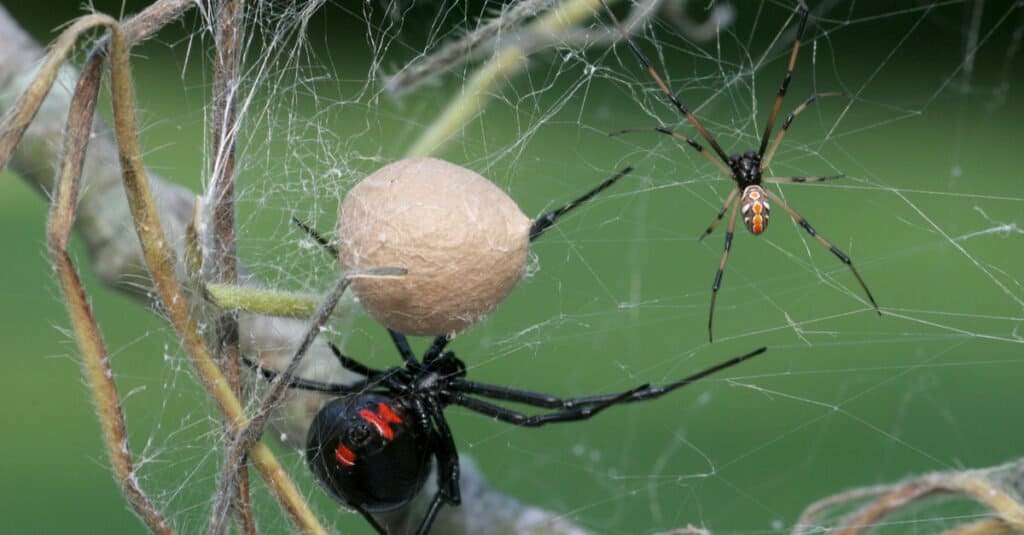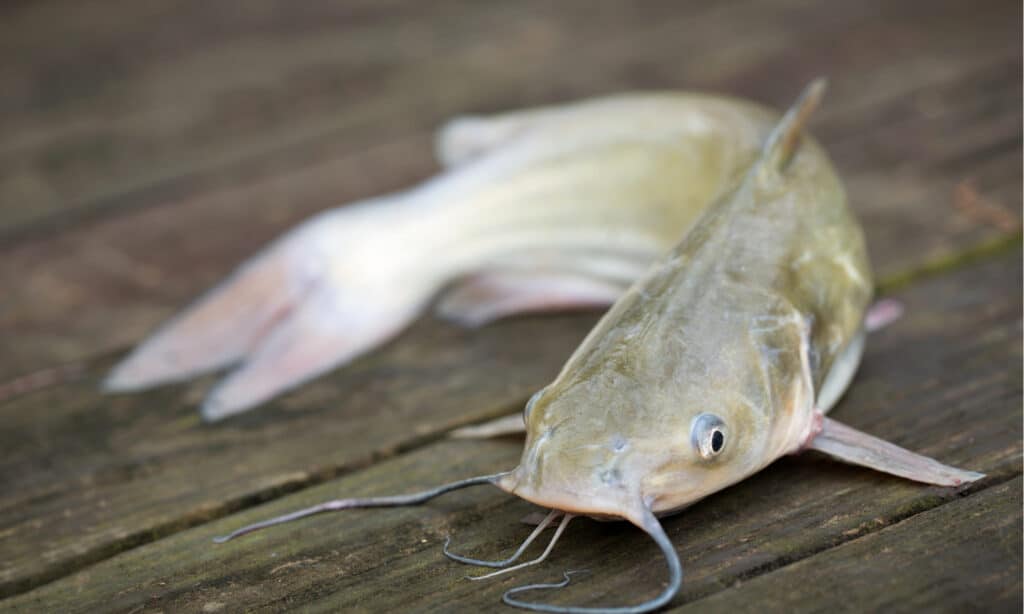There are five National Parks sites in Nebraska including Agate Fossil Beds National Monument and Scotts Bluff National Monument. Hiking in these parks you may be able to see bighorn sheep, coyotes and prairie dogs. There are also prairie rattlesnakes, which are venomous, and yes, can be dangerous.
But what are the most dangerous animals in Nebraska? We’ll dig into wildlife in the state and which ones you need to be on the lookout for!
The geography of Nebraska

Sunset over Scottsbluff National Monument at Gering Nebraska
©iStock.com/LIKE HE
Nebraska is farm country with 92% of the state used for farms and ranches. They are even the number one producer of popcorn in the United States! That is one of the reasons they call it the “Cornhusker” state. Their most profitable crops/livestock are cattle and calves, corn, soybeans, hogs, and dairy products.
Nebraska also has several large rivers flowing through it including the Missouri River and the North Platte River, both of which are the home to many fish species including the channel catfish, the state’s official fish. The channel catfish is the smallest of the three most common catfish, but can still weigh up to 30lbs. Blue and flathead catfish can get to be more than 100lbs but most are closer to 50lbs.
Are cattle and hogs dangerous farm animals?

Ranching is common across Nebraska.
©M. Vinuesa/Shutterstock.com
Two of the main livestock in Nebraska are cattle and hogs. Nebraska has both beef cattle and dairy cattle, both bred for their specific products. An adult male bull can be as much as 2000lbs! The average weight of all the beef cow breeds is 1,390lbs, so ranchers are working with a herd of large animals. According to a research study that looked at cattle-related fatalities in four common ranching states (Iowa, Kansas, Missouri, and Nebraska) the records showed there were 108 fatalities involving cattle over the period of 2003-2007. The most common incident causing a fatality was ranchers working in an enclosed area with the cattle (33% of the fatalities) with the second leading cause was moving and herding the cattle (24%). Proper training and consistently following the best practices in cattle care can help prevent accidents on the farm. The same applies to the handling and care for hog farmers.
What animals are dangerous in the parks of Nebraska?

Coyotes are rarely dangerous to humans but can pose a thraet to pets.
©Brenda Carson/Shutterstock.com
With so much land stretching across more than 75,000 square miles, there are a number of animals that call Nebraska home. Here are a few that are potentially dangerous across Nebraska’s many national and state parks.
- Coyotes: Coyotes look like wolves but are not as big as you may think. They can be 3 ½ to 4 ½ feet long but only weigh 20-50lbs, so a little smaller than a golden retriever. They do have large canine teeth and claws that are sharper than a domestic dog. They live in many of the national and state parks in Nebraska but they also sometimes venture into the city. One coyote wandered into Lincoln and attacked a woman’s small Yorkie dog. In Oct. 2021, Ellen Hadley let her dog out in the middle of the night to go to the bathroom, putting the dog on a leash and watching from the door like she usually did, when she saw the leash suddenly tighten she knew something was up. She stepped outside and saw a coyote, with her dog in its mouth! She was able to chase the coyote away and save her dog but it did need emergency care and stitches. Coyotes rarely attack humans but pets are at risk, even when fenced in, coyotes are clever and can hop your average 3-foot fence to find what they consider dinner. That is why it is important to report coyote sightings so officials can decide how to handle a coyote if they are repeatedly venturing into human territory.
- Bighorn sheep: There aren’t a lot of them but there are a few herds of bighorn sheep in Nebraska. In 1981, these sheep were reintroduced into the state and can now be found in Fort Robinson State Park and Scotts Bluff National Monument. The bighorns in Nebraska are the Rocky Mountain bighorn, which is the largest sheep species and can grow to be 300lbs. The most impressive feature is their curled horns that both the females and males have, but the males are larger. The horns are present for their whole life and can weigh as much as 30lbs. You would not want to be rammed by 30lbs of horns! However, bighorns are more afraid of humans and only use their horns to ram each other during “the rut” which is their mating season. Keeping your distance from a herd of bighorn sheep is the safest way to enjoy their presence.
- Rattlesnakes: There are four venomous snakes in Nebraska including the timber rattlesnake, prairie rattlesnake, copperhead, and massasauga. These snakes vary in size but have the common triangle head of a viper and a rattle at the end of their tail to warn off anyone who approaches. According to the CDC, there are 7,000-8,000 people bitten by venomous snakes a year in the US, but of those there are only an average of 5 fatalities a year. The venomous snakes that are native to the US have far less lethal venom than the world’s most venomous snakes (like the saw-scaled viper, inland taipan and black mamba which are not native to the US) and we also have access to antivenin compared to other nations in the world.
Are there any other poisonous or venomous animals in Nebraska?

Black widows can now be found across the contiental United States
©Mark_Kostich/Shutterstock.com
Beyond its four venomous snakes, there are also some other venomous animal in the state to be aware of.
- Black Widow spiders: There are black widow spiders in Nebraska but they tend to keep to themselves. Unless they are startled or threatened they will leave humans alone. If you do get bit you should seek medical attention.
- Brown Recluse spiders: Brown recluse spiders are smaller than black widows and can deliver a nasty bite, but again they prefer to stay out of the way of humans. They may hide under rocks, under furniture, or in woodpiles so be cautious around these areas. A brown recluse bite may not have any effect on some people whereas others will need medical attention. Some bites leave an ulcer-like sore that takes weeks to heal.
- Bees, Wasps, and Hornets: All of these stinging insects can cause people to have an anaphylactic attack, which can be fatal. In the US there is an estimated average of 62 deaths a year due to stings. Most people have localized pain with possible nausea and discomfort, but others need to seek medical attention immediately.
Is the state fish, the Channel Catfish, dangerous?

Channel catfish are the state fish of Nebraska.
©Jennifer White Maxwell/Shutterstock.com
Catfish get their name from the whiskers that appear on their faces that look just like cat whiskers. The channel catfish can get to be 30lbs with the blue and flathead species growing to be 100lbs or more. The record for the largest channel catfish caught in Nebraska was just set this past year in July 2021. Hunter Jordan speared a 27lb 5ounce channel catfish in the Box Butte Reservoir to set the record. Trying to haul in a fish that large definitely has its dangers but the unique feature of catfish is, in addition to whiskers, they have spines that come out of the front of their bodies near their dorsal fins and these spines are venomous. If you do get stung, first aid involves soaking the area in hot water and removing any visible spines with tweezers. Seek medical attention if you need it. Wearing proper hand wear when fishing and knowing how to handle the catfish can help protect you from a sting. That way you can be safe and enjoy a Zesty Baked Catfish dinner!
A list of dangerous animals in Nebraska
Some of the most dangerous animals in Nebraska include:
- Cattle: Cows kill about 22 people annually.
- Coyotes: Can be dangerous to pets.
- Mountain Lions: Nebraska has breeding populations of mountain lions in the Pine Ridge, Wildcat Hills, and Niobrara River Valley.
- Black Bears: While Nebraska lacks a resident population, a black bear was collected within the state in 2008. It was the first black bear taken in Nebraska since 1907!
- Snakes: Nebraska is home to four venomous snakes including the timber rattlesnake, massasauga, prairie rattlesnake, and copperhead.
- Spider: The two most harmful spiders in the state are the brown recluse and black widow.
The photo featured at the top of this post is © Harris Motion Photo/Shutterstock.com
Thank you for reading! Have some feedback for us? Contact the AZ Animals editorial team.






